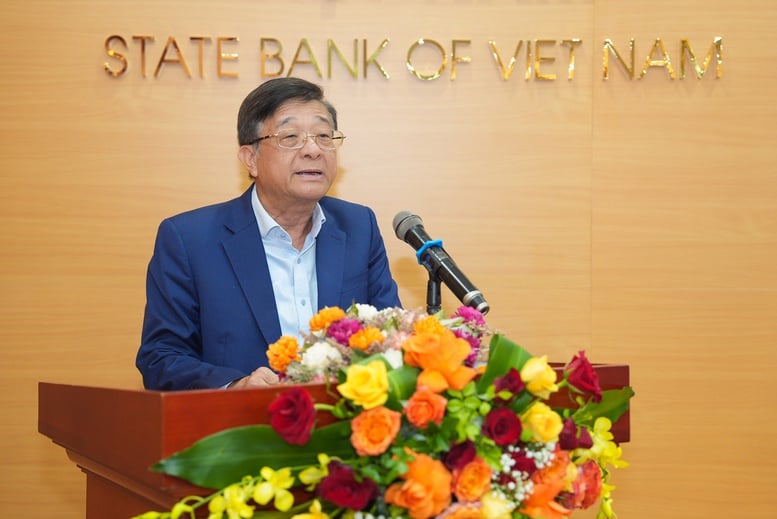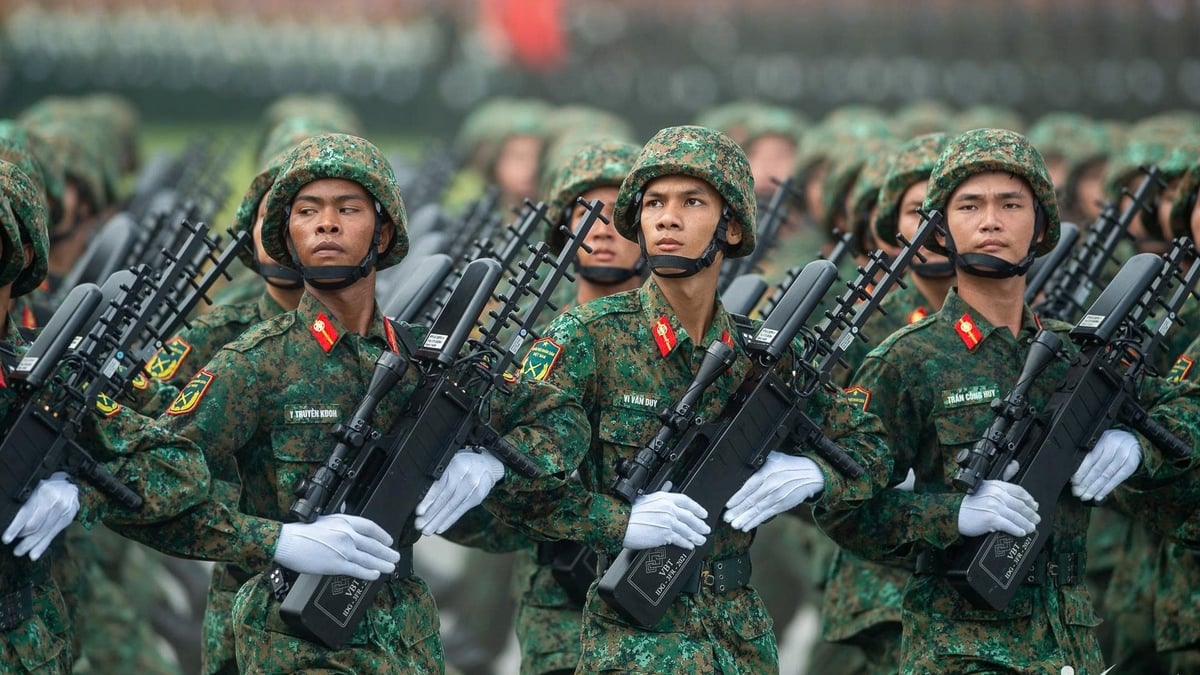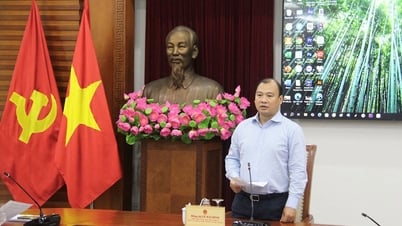Dr. Nguyen Quoc Hung, Vice Chairman and General Secretary of the Vietnam Banks Association shared information at the seminar - Photo: VGP/HT
AI has become a strategic factor, shaping banking operations
At the seminar "Application of AI in communication of policies and banking products and services" organized by Banking Times, Dr. Nguyen Quoc Hung, Vice Chairman and General Secretary of the Vietnam Banking Association emphasized: AI is no longer just a support tool, but has become a strategic factor, capable of reshaping the operation, management and policy communication methods of the banking system.
Mr. Nguyen Quoc Hung said that the key factor in applying AI is not only technology, but more importantly, it must start from the bank's top leadership strategy.
"The most important thing is that the Board of Directors and the Executive Board must come up with a strategy that effective AI, applied to operations, will reduce costs and improve efficiency. There are banks where the Chairman of the Board of Directors and the General Director must directly participate, not assigning it to lower levels. If the application is to be successful, the Board of Directors must issue a resolution, and the leader must participate," Mr. Hung emphasized.
However, Mr. Hung also warned that, besides the benefits, if the negative side cannot be controlled, the risks are very high, especially in the banking sector which is closely linked to money and customer interests.
"If an incident occurs, the consequences could lead to a crisis of confidence. Therefore, many banks have proactively built multi-layered security systems, and at the same time considered investment in cybersecurity an indispensable priority in the implementation process," Mr. Hung noted.
A representative of the Vietnam Banking Association said that the legal foundation for AI application has been consolidated. Resolution 57-NQ/TW of the Politburo identifies science and technology, innovation and digital transformation as strategic breakthroughs. Decision 67/QD-NHNN approving the Digital Transformation Project of the Banking Industry and Decree 94/2025/ND-CP on banking sandboxes create an important legal corridor for safe and oriented AI application deployment.
Another notable point is the synchronization in the entire ecosystem. Mr. Hung believes that banks need to soon build a common ecosystem with the consensus of members, under the connection of the Banking Association.
Along with that is the issue of human resource training. AI and digital transformation cannot be considered "digital literacy". Training must be for both practitioners, data managers, and middle and senior leaders. If leaders are "not proficient or even ignorant", the implementation process will be hindered. AI will only become a sustainable driving force when there is a strategy that combines technology, people and institutions.
From there, Mr. Hung made four recommendations: building an AI ethics and governance framework; strengthening cooperation between banks, fintechs and research institutes; prioritizing investment in technology and data infrastructure; and developing high-quality human resources. At the same time, continue to contribute ideas and perfect policies related to AI, especially on personal data protection and legal responsibility.
AI accompanies customers, from management to communication
From the perspective of commercial banks, Mr. Nguyen Khac Trung - Head of Digital Banking Department of Agribank emphasized that in the context of customers in rural, remote and isolated areas still having many limitations in accessing technology, the application of AI brings clear efficiency, helping to shorten the gap and improve the ability to popularize financial services.
AI at Agribank not only improves the process of providing products and services, but is also especially useful in communication. The AI system can advise, answer, and support customers 24/7, flexibly customized according to regional languages and cultures. This is a solution to save human resources while improving access efficiency.
In crisis management, the "social listening" tool helps Agribank monitor, detect abnormal signals, analyze causes and provide timely response solutions. AI also supports multilingual and visual communication, contributing to removing cultural barriers, especially for ethnic minority customers.
However, Mr. Trung acknowledged three challenges: technology infrastructure requires high costs; high-quality human resources are limited; and customers are wary, especially when faced with the risk of online fraud. To overcome this, Agribank has increased investment in infrastructure, data security, built a big data system, focused on recruitment and training, and launched the "digital ambassador" and "digital core" movements to popularize skills.
For customers, Agribank deploys comprehensive utilities on digital platforms, combining communication via social networks and television. In particular, the bank focuses on using familiar local languages and images to help people access more easily.
Emphasizing the human factor, Associate Professor, Dr. Pham Manh Hung, Deputy Director of the Institute of Banking Science Research (Banking Academy), affirmed: Digital transformation is essentially a story of humans, not machines. AI is a tool, and humans must be the subject.
Mr. Pham Manh Hung emphasized the "T" skill model: the vertical dimension is the foundation of deep expertise (credit, payment, appraisal), while the horizontal dimension is digital skills such as data analysis, legal knowledge, and technological thinking. Only when combined harmoniously can banking human resources master AI.
Many Vietnamese banks have experimented with AI in analyzing transaction data, suggesting products, and improving customer experience. But the biggest challenge now is training and retraining human resources. International lessons show that many banks have established AI academies, collaborating with major universities to provide lifelong training.
Mr. Nguyen Van Hao, Academy of Journalism and Communication, shared: In the banking sector, policy and product communication face many challenges such as fake news, high-tech crime, and competition with similar products. AI and multimedia journalism are considered effective assistants to help solve these problems. AI analyzes big data, personalizes information, produces automatic content, supports 24/7 chatbots, and monitors social networks to detect risks. In parallel, multimedia journalism with videos, podcasts, and infographics helps messages spread easily and attract the younger generation. The combination of AI and multimedia helps banks accelerate communication, increase credibility, expand customer access, and effectively manage crises. However, there are still concerns about journalistic identity when AI-generated content risks lacking creativity and being easily repetitive.
Therefore, AI should be a supporting tool, not a replacement for humans. International newsrooms such as AP, BBC or The Washington Post have demonstrated the effectiveness of combining AI with journalistic control.
Mr. Minh
Source: https://baochinhphu.vn/ung-dung-ai-chia-khoa-doi-moi-quan-tri-va-truyen-thong-ngan-hang-102250820192901107.htm

























![[Photo] An Phu intersection project connecting Ho Chi Minh City-Long Thanh-Dau Giay expressway behind schedule](https://vphoto.vietnam.vn/thumb/1200x675/vietnam/resource/IMAGE/2025/8/21/1ad80e9dd8944150bb72e6c49ecc7e08)
![[Photo] Prime Minister Pham Minh Chinh receives Australian Foreign Minister Penny Wong](https://vphoto.vietnam.vn/thumb/1200x675/vietnam/resource/IMAGE/2025/8/20/f5d413a946444bd2be288d6b700afc33)

![[Photo] Politburo works with Standing Committees of Lang Son and Bac Ninh Provincial Party Committees](https://vphoto.vietnam.vn/thumb/1200x675/vietnam/resource/IMAGE/2025/8/20/0666629afb39421d8e1bd8922a0537e6)














































































Comment (0)